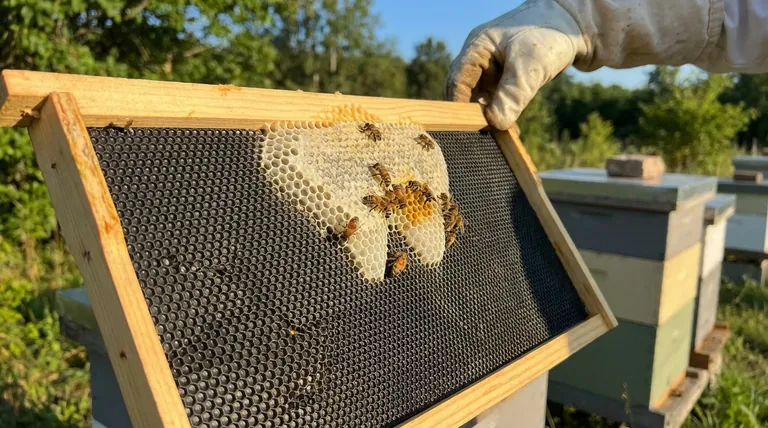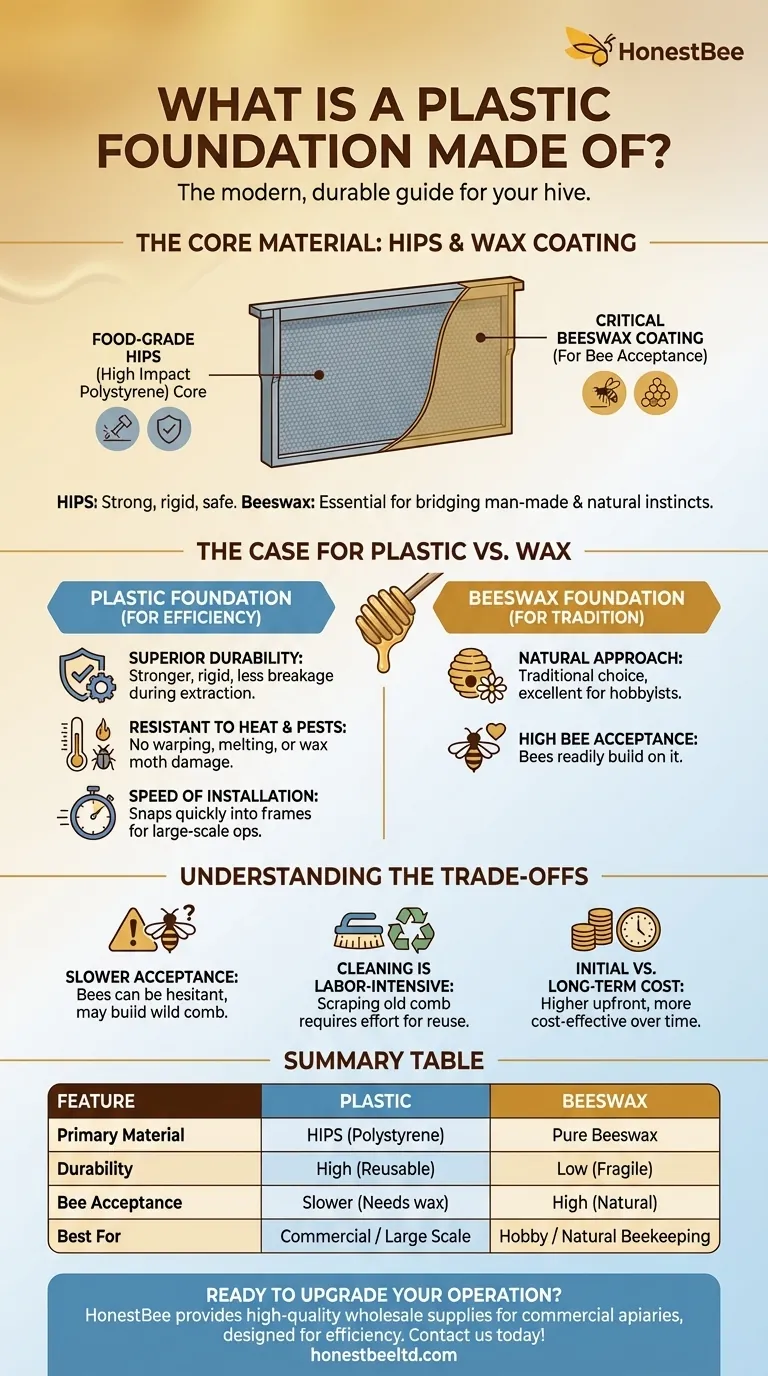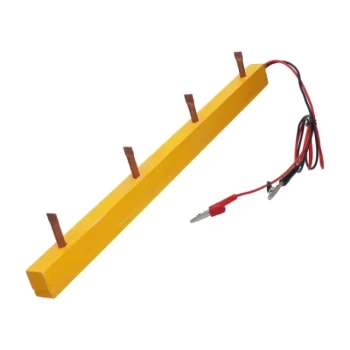At its core, a plastic beekeeping foundation is made of food-grade High Impact Polystyrene (HIPS). This specific type of plastic is chosen for its strength and safety, providing a durable and reusable alternative to traditional beeswax foundation for guiding honeycomb construction within a beehive.
Plastic foundation offers a significant advantage in durability and ease of use, especially for commercial operations. However, its primary trade-off is that honey bees can be more hesitant to build on it compared to natural beeswax.

Why Plastic Foundation Exists
A foundation sheet, whether plastic or wax, provides a guide for bees. It gives them a base with the hexagonal cell pattern imprinted on it, encouraging them to build straight, uniform honeycomb that is easy for the beekeeper to inspect and manage.
The Core Material: HIPS
The material of choice is High Impact Polystyrene (HIPS). It is a food-grade plastic, ensuring that it is safe for contact with honey that will eventually be consumed. This material provides the rigidity needed to support the heavy weight of honey and brood.
The Critical Beeswax Coating
To encourage bees to accept and build on the plastic surface, manufacturers almost always apply a thin layer of beeswax. This coating helps bridge the gap between a man-made material and the bees' natural instinct to work with wax. The quality and thickness of this wax coating can significantly impact how quickly a colony accepts the foundation.
Color Variations and Their Purpose
Plastic foundation is available in various colors, most commonly black or white. Black foundation makes it much easier for a beekeeper to see white eggs and young larvae, aiding in hive inspections. The color choice is largely a matter of manufacturer and beekeeper preference.
The Case for Plastic vs. Wax
While beeswax foundation is the traditional choice, plastic has gained significant traction for several practical reasons, particularly in larger-scale beekeeping operations.
Superior Durability
Plastic foundation is far stronger and more rigid than beeswax. It is less likely to break during honey extraction in a centrifugal extractor and can withstand the rigors of handling and transport far better than delicate wax.
Resistance to Heat and Pests
Unlike beeswax, which can warp or melt in very high temperatures, plastic foundation maintains its structural integrity. It is also completely invulnerable to pests like wax moths, which can devastate stored beeswax combs.
Speed of Installation
For beekeepers managing hundreds or thousands of hives, time is a critical factor. Plastic foundation is designed to snap easily into frames, especially wood frames with a grooved top and bottom bar, dramatically speeding up the process of assembling new equipment.
Understanding the Trade-offs
No material is perfect, and a decision to use plastic foundation comes with important considerations.
Bee Acceptance is Not Guaranteed
The most common issue with plastic foundation is slower acceptance by the bees. Even with a wax coating, some colonies are reluctant to draw out the comb, choosing to build their own "wild" comb in other empty spaces in the hive instead.
Cleaning and Reusability
While plastic is reusable, cleaning it is a labor-intensive task. Scraping off old comb, cocoons, and propolis to prepare the foundation for reuse requires significant effort. If not cleaned properly, it can also pose a risk of transferring diseases between colonies.
Initial vs. Long-Term Cost
Plastic foundation and the frames they fit in often have a higher upfront cost than their wax counterparts. However, their longevity and reusability can make them more cost-effective over the long term, as they do not need to be replaced as frequently.
Making the Right Choice for Your Hive
Choosing a foundation material depends entirely on your beekeeping goals, management style, and scale of operation.
- If your primary focus is efficiency and long-term durability: Plastic foundation is the superior choice due to its strength, reusability, and speed of assembly.
- If your primary focus is a natural beekeeping approach or you run a small hobby apiary: Traditional beeswax foundation is an excellent and reliable option that bees readily accept.
Ultimately, your decision should balance the operational benefits of plastic against the natural appeal and ready acceptance of beeswax.
Summary Table:
| Feature | Plastic Foundation | Beeswax Foundation |
|---|---|---|
| Primary Material | High Impact Polystyrene (HIPS) | Pure Beeswax |
| Durability | High (Reusable, pest-resistant) | Low (Fragile, can melt) |
| Bee Acceptance | Slower (Requires wax coating) | High (Natural instinct) |
| Best For | Commercial apiaries, large-scale operations | Hobbyists, natural beekeeping |
Ready to upgrade your operation with durable, long-lasting plastic foundation?
As a trusted wholesale supplier, HONESTBEE provides commercial apiaries and equipment distributors with high-quality beekeeping supplies designed for efficiency and scale. Our plastic foundations offer the superior durability and time-saving installation that growing operations need.
Contact our team today to discuss your wholesale needs and learn how our products can support your success.
Visual Guide

Related Products
- Food Grade Plastic bee Foundation for Bee Frames
- Heavy Duty Stainless Steel Honeycomb Cutter
- JZBZ Type Wide Base Plastic Queen Cell Cups for Base Mounting and Queen Rearing
- High Performance Plastic Queen Excluder for Beekeeping and Apiary Management
- Plastic Hand Crank 2 Frame Honey Extractor Low Price
People Also Ask
- Does plastic foundation affect honey quality or taste? A Practical Guide for Beekeepers
- What factors should beekeepers consider when choosing between beeswax and plastic foundation? A Guide to Durability vs. Natural Philosophy
- What additional step can improve the performance of plastic foundation in the hive? Apply a Generous Coat of Beeswax
- Why do commercial beekeepers prefer plastic foundation? Durable, Reusable, and Cost-Effective
- Why is it beneficial to coat plastic foundation with beeswax? Boost Hive Acceptance & Comb Building



















